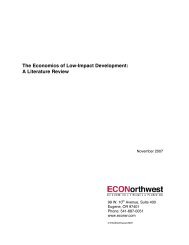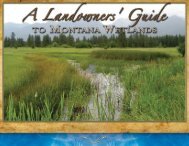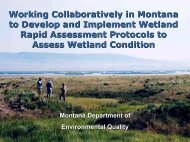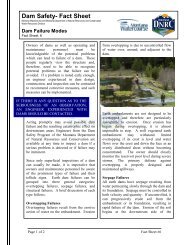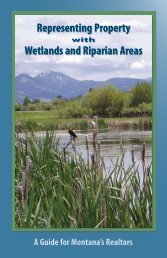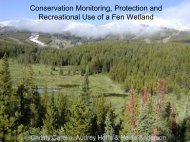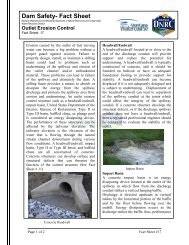McGraw, Maryann
McGraw, Maryann
McGraw, Maryann
You also want an ePaper? Increase the reach of your titles
YUMPU automatically turns print PDFs into web optimized ePapers that Google loves.
new mexico<br />
wetlands and riparian areas<br />
from plan to action<br />
Presentation by <strong>Maryann</strong> <strong>McGraw</strong><br />
New Mexico Environment Department<br />
Surface Water Quality Bureau<br />
Wetlands Program
new mexico wetlands facts<br />
•Wetlands cover about 482,000 acres or<br />
•Less than 1% of the State’s land area and<br />
•1/3 of previous 720,000 that probably<br />
existed 200 years ago (USFWS, Dahl 1990)<br />
•Approximately 25%<br />
of NM land area<br />
contains closed<br />
basins and/or<br />
isolated wetlands<br />
New Mexico
new mexico ecoregions<br />
Griffith and Omernik, 2005
new mexico wetlands types<br />
riverine<br />
lacustrine<br />
palustrine<br />
Photo by Danny Davis, NMED
new mexico wetlands types<br />
playa lakes<br />
isolated wetlands statewide<br />
springs
new mexico target watersheds<br />
playas<br />
playas<br />
closed basins
elements of a watershed plan<br />
watershed groups develop wras’s<br />
üdescription of watershed<br />
üidentification of water quality issues<br />
ümonitoring and load reduction – tmdls<br />
üoutreach and education – stakeholder<br />
involvement<br />
üpollution control and watershed<br />
restoration measures<br />
üschedule of activities<br />
üfunding needs
wetlands action plan program<br />
‣builds on and complements the<br />
wras process!<br />
the “wetlands action plan” will include<br />
the identification of wetlands resources<br />
and measures to protect, restore and<br />
create new wetlands on a watershed basis
elements of a wetlands action plan<br />
1. resource analysis<br />
üidentify and inventory existing wetlands<br />
resources in the watershed, develop gis<br />
coverage<br />
üreview documentation of historical<br />
wetlands resources by watershed or<br />
geographical area<br />
üidentify function and value of wetlands,<br />
and locate reference reaches<br />
üidentify threats and impairments
identify wetlands resources<br />
Wetlands Inventory<br />
‣ An inventory of wetland<br />
resources is compiled from<br />
aerial photographs, the<br />
National Wetland Inventory,<br />
Natural Resources<br />
Conservation Service soil<br />
maps, U.S.G.S. quad maps,<br />
and any available local<br />
references. Potential wetland<br />
sites are then fieldverified.<br />
National Wetlands Inventory,USFWS
historical documentation<br />
Checking original survey<br />
maps of pond at ERDLG<br />
function and value assessment
impacts causing decline<br />
and disappearance of these<br />
ecosystems<br />
•Ground water pumping lowering water tables<br />
•Vegetation Removal<br />
•Development<br />
•Livestock and wildlife grazing
impacts causing decline<br />
and disappearance of these<br />
ecosystems<br />
•Agriculture<br />
•Introduced exotic species<br />
•Flood control
elements of a wetlands action plan<br />
2. resource management<br />
üprioritize sites with potential for reclamation,<br />
restoration, preservation, and/or<br />
enhancement of ecological integrity of the<br />
resource<br />
üdevelop measures to protect, restore,<br />
enhance and create new wetlands<br />
ülist proposed projects to protect, restore,<br />
enhance and create new wetlands
elements of a wetlands action plan<br />
3. local involvement strategy<br />
üsteering committee<br />
ücore of volunteers<br />
üinformational programs and activities<br />
ügrant writers and funding opportunity<br />
tracking<br />
ümonitoring project successes
planning in action!<br />
El Restauro<br />
Stewart Meadows<br />
Cedro Creek<br />
Galisteo Creek
planning for wetlands<br />
in the galisteo watershed
planning in action!
planning in action!<br />
planning for wetlands<br />
in the galisteo watershed
estoration measures<br />
Restoring Wetlands and Training Restoration Specialists<br />
on Cedro Creek Project<br />
Cedro Creek Priority 1 Reaches Structure Assessment and Material Estimations<br />
Reach<br />
Reach<br />
Length<br />
Structure/Description<br />
Estimated Size<br />
in Feet<br />
Est. Volume<br />
Cubic Feet<br />
Filter Dam<br />
6 X 8 X 3<br />
144<br />
Mahogany<br />
1735 ft<br />
4 baffles<br />
4 weirs/ meander<br />
(with ~ 1.5 meanders)<br />
12 X 24 X 1.5 / 2<br />
16 X 16 X 1.5<br />
2592<br />
1536<br />
2 headcuts 2 log and<br />
fabric<br />
6 X 8 X 1<br />
48<br />
Mt. Lion<br />
1333 ft.<br />
wire or masonry<br />
structure trail crossing<br />
12 X 8 X 4<br />
768<br />
move bike trail up rll<br />
bank remove trees<br />
12 X 8 X 4<br />
384<br />
Develop specific wetland protection and restoration measures based<br />
on location, function and other attributes.
estoration measures<br />
Headcut control structure<br />
developed and designed by<br />
Bill Zeedyk.
estoration measures<br />
Flow control structures designed by Bill Zeedyk.
estoration techniques
site planning<br />
STEWART MEADOWS WETLAND WATERFOWL<br />
HABITAT PARTNERSHIP PROJECT
stewart meadows master plan
planning in action!<br />
conejos watershed wetlands action plan
El Restauro<br />
Wetland/Riparian Restoration on the Rio Grande<br />
Process:<br />
Watershed/Wetlands Planning Tasks<br />
Talk to community members and listen<br />
to community response to discover<br />
community and environmental needs<br />
– past, present and future.<br />
Present the El Restauro project idea and collected<br />
responses in a community town hall.<br />
Form an Upper Rio Grande Watershed Working Group to<br />
develop a Wetlands Action Plan.
El Restauro Phase 1<br />
Planning Tasks cont’d.<br />
Offer a series of educational opportunities that focus on<br />
projects and solutions that address cultural and<br />
environmental issues.<br />
Implement community and environmental projects with<br />
stakeholder involvement.<br />
Seek out funding sources for different parts of the<br />
project.<br />
Document environmental and community responses to<br />
activities in a video and book.<br />
Only when events are rooted in the soil of the culture might they have a reality that endures.<br />
Paul Horgan, 1954
El Restauro Phase 1<br />
Demonstration Wetlands Project Tasks<br />
Photos by Yesca Sullivan
El Restauro Phase 2 and beyond<br />
Phase 2 and beyond will implement prioritized<br />
projects developed from the Wetlands Action Plan and<br />
from the Watershed Restoration Action Strategy.
who gets selected to participate?<br />
üexcellent track record for completing<br />
innovative projects<br />
üpreponderance of wetlands or riparian<br />
acreage in need of restoration or<br />
protection in the watershed<br />
üwilling to restore 30 acres or more of<br />
wetlands<br />
üunique situation or opportunity in the<br />
watershed<br />
üunique need for wetlands an riparian area<br />
awareness and protection
incentives for the<br />
watershed group<br />
üway of continuing watershed restoration<br />
üway of continuing and complementing<br />
other water quality improvement<br />
efforts<br />
üway of targeting other water resources<br />
in the watershed not targeted by<br />
other programs<br />
üadditional funding for projects and<br />
planning<br />
üadditional opportunity for education and<br />
outreach
incentives for the<br />
watershed group<br />
üswqb visits watershed groups to sell the<br />
program<br />
üswqb provides guidance and technical<br />
assistance<br />
üswqb and watershed group preplan<br />
üswqb and watershed group develop<br />
proposals<br />
üswqb will develop wetlands database and<br />
tracking component
Thank you!<br />
From the New Mexico Wetlands Action Plan Program



